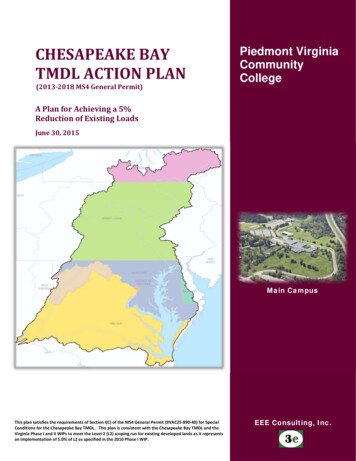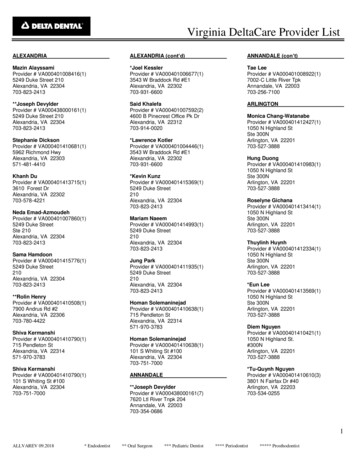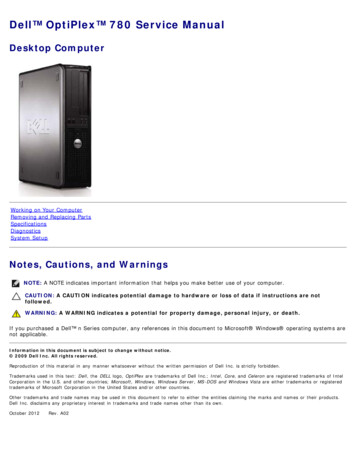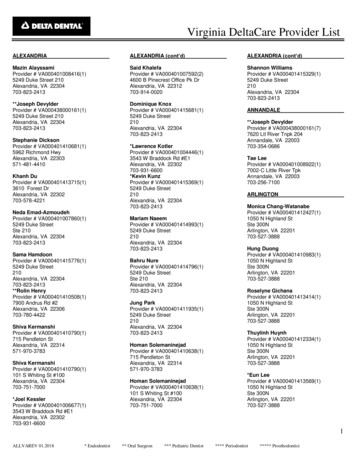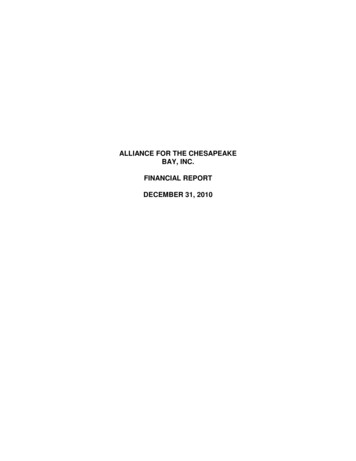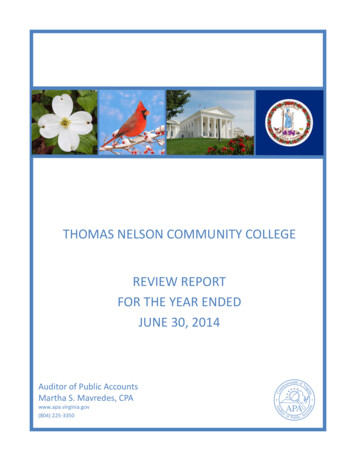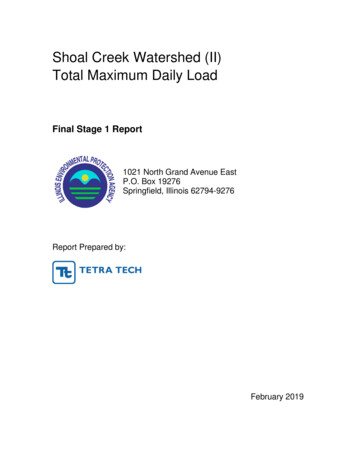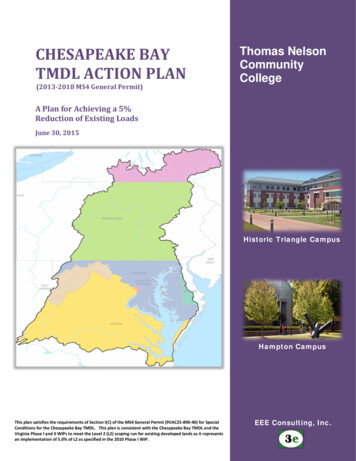
Transcription
CHESAPEAKE BAYTMDL ACTION PLAN(2013-2018 MS4 General Permit)Thomas NelsonCommunityCollegeA Plan for Achieving a 5%Reduction of Existing LoadsJune 30, 2015Historic Triangle CampusHampton CampusThis plan satisfies the requirements of Section I(C) of the MS4 General Permit (9VAC25-890-40) for SpecialConditions for the Chesapeake Bay TMDL. This plan is consistent with the Chesapeake Bay TMDL and theVirginia Phase I and II WIPs to meet the Level 2 (L2) scoping run for existing developed lands as it representsan implementation of 5.0% of L2 as specified in the 2010 Phase I WIP.EEE Consulting, Inc.
Thomas Nelson Community CollegePhase I Chesapeake Bay TMDL Action PlanEXECUTIVE SUMMARYThomas Nelson Community College (TNCC), is authorized to discharge stormwater from itsmunicipal separate storm sewer system (MS4) under the Virginia Pollutant Discharge EliminationSystem (VPDES) General Permit for Discharge of Stormwater from Small MS4s (MS4 GeneralPermit). To maintain permit compliance, TNCC implements an MS4 Program Plan that includesbest management practices (BMPs) to address six minimum control measures (MCMs) andspecial conditions for the Total Maximum Daily Load (TMDL) in which TNCC has been assigned awasteload allocation (WLA). The Environmental Protection Agency (EPA) describes a TMDL as a“pollution diet” that identifies the maximum amount of a pollutant the waterway can receive andstill meet water quality standards. A WLA determines the required reduction in pollutant ofconcern loadings from the MS4s to meet water quality standards. The MS4 General Permit servesas the regulatory mechanism for addressing the load reductions described in the TMDL,predominantly through the requirement of a TMDL Action Plan.The Chesapeake Bay TMDL was established by the EPA on December 29, 2010 and initiated WLAsfor phosphorus, nitrogen and total suspended solids. In response, the Commonwealth of Virginiadeveloped Watershed Implementation Plans (WIPs) that, in part, identify the MS4 General Permitas a mechanism for enforcing load reductions in urban areas. Subsequently, the Commonwealthincluded special conditions into the latest MS4 General Permit to address the reductions requiredby the TMDL for the pollutants of concern. The WIPs intended the reductions to be achievedover the course of three 5-year permit cycles, with the first cycle (2013 – 2018) requiring 5% ofthe reductions be achieved. Reduction requirements for the following two permit cycles areanticipated to increase substantially, requiring an additional 35% and 60% of the reductions beachieved, respectively.TNCC has developed an Action Plan consistent with the Chesapeake Bay Action Plan GuidanceMemo (Memo No. 15-2005) provided by the Virginia Department of Environmental Quality(DEQ). The guidance was used to determine the required pollutant load reductions for eachregulated campus, the Historic Triangle campus in the James River basin and the Hamptoncampus in the York River basin. Subsequently, the means and methods for achieving pollutantreductions required by the current MS4 General Permit within each basin were identified: Historic Triangle campus: required pollutant load reductions are achieved with an existingregional stormwater management facility that treats the entirety of the developedcampus. Hampton campus: required pollutant load reductions will be achieved withimplementation and documentation of street sweeping efforts.i
Thomas Nelson Community CollegePhase I Chesapeake Bay TMDL Action PlanTable of Contents1.0Introduction and Purpose . 11.1 Total Maximum Daily Loads . 11.2 MS4 General Permit Special Conditions . 21.3 Watershed Implementation Plan and Strategy for MS4s . 21.4 TNCC Chesapeake Bay Action Plan. 22.0Applicable Overview of TNCC’s MS4 Program. 32.1 Current Program and Existing Legal Authority. 32.2 New or Modified Legal Authorities . 53.0Pollutant Loadings. 63.1 Baseline Loading Characterization . 63.2 Annual Loadings from Existing Sources . 63.3 Annual Loadings from New Sources and Grandfathered Projects . 73.4 Required Load Reductions . 84.0Means to Achieve Pollutant Reductions . 104.1 Reductions for the Historic Triangle Campus. 104.2 Reductions for the Hampton Campus. 125.0Implementation to the MEP . 135.1 Supplemental Means and Methods . 135.2 Public Comment Period. 135.3 Annual Reporting . 14TablesTable 1: Classification of Campus Land Cover Area (Acres). 6Table 2: Baseline loadings from the Historic Triangle Campus in the James River Basin . 7Table 3: Baseline loadings from the Hampton Campus in the York River Basin . 7Table 4: Estimated POC Reductions for the Historic Triangle Campus in the James River Basin. 9Table 5: Estimated POC Reductions for the Hampton Campus in the York River Basin . 9Table 6: Summary of POC Reductions from the Warhill Pond . 11Table 7: Required Street Sweeping per the Mass Loading Approach . 12AppendicesAppendix A: Mapping for Characterization of TNCC CampusesAppendix B: Supporting POC Reduction CalculationsAppendix C: BMP Reporting Affirmation Statementii
Thomas Nelson Community CollegePhase I Chesapeake Bay TMDL Action MEPMS4MS4 Best Management PracticeConstruction General PermitCensus Urban AreaClean Water ActVirginia Department of Environmental QualityEdge of StreamEnvironmental Protection AgencyErosion and Sediment ControlGeographic Information SystemIllicit Discharge Detection and EliminationLoad AllocationLevel 2Minimum Control MeasureMaximum Extent PracticableMunicipal Separate Storm Sewer SystemGeneral Permit for Discharge of Stormwater from Small MS4sNutrient Management PlanPollutant of ConcernRegulated Land Disturbing ActivityStormwater Pollution Prevention PlanStormwater ManagementTotal Maximum Daily LoadThomas Nelson Community CollegeVirginia Administrative CodeVirginia Community College SystemVirginia Pollutant Discharge Elimination SystemVirginia Stormwater Management ProgramWatershed Implementation PlanWasteload Allocationiii
Thomas Nelson Community CollegePhase I Chesapeake Bay TMDL Action PlanDefinitionsBest Management Practices (BMPs) are schedules of activities, prohibitions of practices,maintenance procedures, and other management practices, including both structural andnonstructural practices, to prevent or reduce the pollution of surface waters and groundwatersystems.Census Urbanized Area (CUA) are areas identified as urban by the Census Bureau. MS4regulations only apply within CUAs.Existing Sources are pervious and impervious urban land uses served by the MS4 as of June 30,2009.Impervious Cover is a surface composed of material that significantly impedes or preventsnatural infiltration of water into soil.L2 Scoping Run is a model run to determine required reductions from urban sources as of June30, 2009. The L2 reductions are summarized in the following table:Pollutant of Concern Regulated Impervious (%) Regulated Pervious al Separate Storm Sewer System (MS4) is a conveyance or system of conveyancesotherwise known as a municipal separate storm sewer system (MS4), including roads withdrainage systems, municipal streets, catch basins, curbs, gutters, ditches, manmade channels, orstorm drains that are: Owned or operated by a federal state, city, town, county, district, association, or otherpublic body, created by or pursuant to state law that discharges to surface waters; Designed or used for collecting or conveying stormwater; That is not a combined sewer; and That is not part of a publicly owned treatment works.New Sources are pervious and impervious urban land uses served by the MS4 developed orredeveloped on or after July 1, 2009.TNCC MS4 Program Plan is the guiding document of the TNCC’s MS4 Program and includes bestmanagement practices to address conditions of the MS4 General Permit.Pollutants of Concern (POC) are total nitrogen (“TN”), total phosphorus (“TP”), and totalsuspended solids (“TSS”).Prior Developed Lands are lands that has been previously utilized for residential, commercial,industrial, institutional, recreation, transportation, or utility facilities or structures, and that willhave the impervious areas associated with those uses altered during a land-disturbing activity.Transitional Sources are regulated land disturbing activities that are temporary in nature anddischarge through the MS4.iv
Thomas Nelson Community CollegePhase I Chesapeake Bay TMDL Action Plan1.0 INTRODUCTION AND PURPOSEMandated by Congress under the Clean Water Act (CWA), theNational Pollutant Discharge Elimination System (NPDES) storm“TNCC’s MS4 programwater program includes the Municipal Separate Storm Sewerstrives to improveenvironmentalSystem (MS4), Construction, and Industrial General Permits. Incompliance, qualityVirginia the NPDES Program is administered by the Departmentand stewardshipof Environmental Quality (DEQ) through the Virginiathrough effectiveStormwater Management Program (VSMP) and the Virginiamanagement,Pollutant Discharge Elimination System (VPDES). John Tylerimplementation, andenforcement.”Community College (TNCC) is authorized to dischargestormwater from its MS4 under the VPDES General Permit forDischarge of Stormwater from Small MS4s (MS4 GeneralPermit). As part of the MS4 General Permit authorization, TNCC developed and implements aMS4 Program Plan (the Plan) with best management practices (BMPs) to address the sixminimum control measures (MCMs) and the special conditions for applicable total maximumdaily loads (TMDLs) outlined in the MS4 General Permit. Implementation of these BMPs isconsistent with the provisions of an iterative MS4 Program, which constitutes compliance withthe standard of reducing pollutants to the "maximum extent practicable” or MEP.The TNCC MS4 program strives to improve environmental compliance, quality and stewardshipthrough effective management, implementation, and enforcement of sound technical guidelines,criteria and practices for stormwater management and erosion and sediment control. The planpresented herein demonstrates how TNCC’s MS4 Program Plan addresses sediment andnutrients (nitrogen and phosphorus) in its MS4 regulated area consistent with the requirementsof the Chesapeake Bay TMDL.1.1 Total Maximum Daily LoadsA TMDL is the total amount of a given pollutant that a waterbody can assimilate and still meetwater quality standards. Typically, TMDLs are represented numerically in three maincomponents: Waste Load Allocations (WLAs), a Load Allocation (LA), and a Margin of Safety. AWLA is the allocated amount of pollutant from areas discharging through a pipe or otherconveyance considered a point source. Point sources include sewage treatment plants, industrialfacilities and storm sewer systems. In contrast, an LA is the amount of pollutant from existingnon-point sources and natural background such as farm runoff and atmospheric deposition. Asa point source discharge, MS4’s are assigned a WLA representing the annual loading of thepollutant of concern (POC) that can be discharged from its regulated MS4 area.1
Thomas Nelson Community CollegePhase I Chesapeake Bay TMDL Action Plan1.2 MS4 General Permit Special ConditionsTNCC’s MS4 General Permit includes a series of special conditions that must be addressed forpermit compliance where TNCC has been assigned a WLA as part of an approved TMDL. Thespecial conditions state that any TMDL approved by the State Water Control Board (SWCB)assigning a WLA to an MS4 must be addressed by the Permittee through the measurable goals oftheir MS4 Program Plan.In 1998, large portions of Chesapeake Bay and its tidal tributaries within Virginia were identifiedas not meeting water quality standards and listed as impaired because of excess nitrogen,phosphorus and sediment. Due to the Chesapeake Bay waters remaining on the impaired waterslist, the Environmental Protection Agency (EPA) required that a TMDL be developed, which wasissued on December 29, 2010.1.3 Watershed Implementation Plan and Strategy for MS4sThe Chesapeake Bay Watershed Implementation Plans (WIPs) are plans that detail how and whenthe six Chesapeake Bay states and the District of Columbia will meet pollutant allocations. In thePhase I and Phase II WIPs for the Chesapeake Bay TMDL, Virginia committed to a phasedapproach to reducing nutrients and suspended solids discharging from MS4s. The issuance ofthe 2013-2018 MS4 General Permit set forth special conditions required by all MS4 GeneralPermit holders within the Chesapeake Bay watershed. In part, the special conditions require thepermittee to achieve 5% of the required reductions identified in the so-called Level 2 ScopingRun from existing baseline loads by July 1, 2018. Baseline loads are defined as those occurringon June 20, 2009, and are computed using loading rates provided in the MS4 General Permit.1.4 TNCC Chesapeake Bay Action PlanThe TNCC Action Plan presented herein provides a review of the current MS4 program, whichdemonstrates TNCC’s ability to ensure compliance with the special conditions and includes themeans and methods TNCC will use to meet 5.0% of the Level 2 (L2) scoping run reduction forexisting development during the first MS4 General Permit cycle. This Action Plan was developedto comply with the special conditions of the MS4 General Permit (9VAC25-890) and under theadvisement of DEQ’s Guidance Memo No. 15-2005 (DEQ Guidance), which provides backgroundinformation and procedures to meet the Chesapeake Bay TMDL special condition requirements.2
Thomas Nelson Community CollegePhase I Chesapeake Bay TMDL Action Plan2.0 APPLICABLE OVERVIEW OF TNCC’S MS4 PROGRAMTNCC’s MS4 General Permit regulates stormwater discharges from areas included within censusurbanized areas (CUAs). TNCC campuses included in CUAs include the Historic Triangle andHampton campuses, as depicted in Appendix A. TNCC’s collective efforts, as described in theTNCC MS4 Program Plan, result in a significant reduction of pollutants that could potentially bedischarged from its regulated MS4. BMPs already included in the TNCC Program Plan thataddress sediment and nutrients are described in the following sections. Each subsection isprovided to address the referenced special condition in the MS4 General Permit.2.1 Current Program and Existing Legal AuthorityAs a non-traditional MS4, TNCC does not have the ability to create legal authorities and has notidentified any necessary legal authorities necessary to meet the requirements of the specialconditions. However, TNCC’s MS4 Program includes Minimum Control Measures (MCMs) thatinclude policies and procedures consistent the goals of the Chesapeake Bay TMDL. A summaryof the applicable MCMs is listed below to address the following special condition: “A review of the current MS4 program implemented as a requirement of this state permit includinga review of the existing legal authorities and the operator's ability to ensure compliance with thisspecial condition.” [Section I(C)(2)(a)(1)] MCM 1 (Public Education and Outreach) – TNCC’s MS4 Program includes a Public Educationand Outreach Program (PEOP) that identifies the Chesapeake Bay TMDL pollutants of concern(POCs) as a high priority water quality issue. The PEOP is described in BMP 1.2 of the TNCCMS4 Program Plan and includes the distribution of educational materials regarding methodsto reduce introduction of the POCs into stormwater runoff. MCM 3 (Illicit Discharge Detection and Elimination) – TNCC’s MS4 Program includes an IllicitDischarge Detection and Elimination (IDDE) Program that includes written procedures todetect, identify, and address non-stormwater discharges, including illegal dumping, to thesmall MS4 with policies and procedures for when and how to use legal authorities. TNCCprohibits non-stormwater discharges into the storm sewer system through languageprovided within the Standards of Conduct for employees and the Student Handbook forstudents. IDDE BMPs are described in the Minimum Control Measure 3 BMPs in the TNCCMS4 Program Plan. The IDDE Program is effective at addressing the POC through stafftraining, prohibition of illicit discharges, and annual outfall screening. MCM 4 (Construction Site Runoff Control) – TNCC’s MS4 Program includes a Construction SiteRunoff Control Program that includes mechanisms to ensure compliance and enforcementon regulated construction sites with implementation of the DEQ-approved “VCCS AnnualErosion and Sediment Control and Stormwater Management Standards and Specifications.”3
Thomas Nelson Community CollegePhase I Chesapeake Bay TMDL Action PlanThe standards and specifications are consistent with the Virginia Erosion and SedimentControl and Stormwater Management Laws and Regulations and includes:o Required plan approval prior to commencement of a regulated land disturbanceactivity;o Construction site inspections and enforcement; ando Certification of post-construction stormwater management facilities.The Construction Site Runoff Control Program is especially effective at reducing downstreamconveyance of sediment from transitional sources. Minimum Control Measure 4 BMPs in theTNCC MS4 Program Plan describe construction site runoff control BMPs. MCM 5 (Post-Construction Stormwater Management) – TNCC’s MS4 Program includes a PostConstruction SWM Program that ensures water quality criteria in the Virginia StormwaterManagement Regulations has been achieved on new developments and developments onprior developed land since July 1, 2009. Included among these requirements are writtenpolicies and procedures in the VCCS Erosion and Sediment Control and StormwaterManagement Standards and Specifications to ensure that stormwater management facilitiesare designed and installed in accordance with appropriate law and regulations. Postconstruction, the Program includes schedules and written procedures to ensure long-terminspections and maintenance of stormwater management BMPs. Minimum Control Measure5 BMPs in the TNCC MS4 Program Plan describe post-construction stormwater managementBMPs.Implementation of this program addresses the following MS4 General Permit specialconditions for the Action Plan to include: “The means and methods that will be utilized to address discharges into the MS4 from new sources[Section I(C)(2)(a)(3)] MCM 6 (Good Housekeeping) – TNCC’s MS4 Program includes a Pollution Prevention/GoodHousekeeping Program that includes policies and procedures to ensure that day-to-dayoperations minimize the exposure of pollutants to rainfall on campus grounds to themaximum extent practicable. The program is supported with TNCC’s Pollution Prevention &Good Housekeeping Manual and annual training for applicable staff. TNCC also utilizescontract language to ensure appropriate certifications for application of fertilizers per a DEQapproved Nutrient Management Plan. Minimum Control Measure 6 BMPs in the TNCC MS4Program Plan describe pollution prevention and good housekeeping BMPs.4
Thomas Nelson Community CollegePhase I Chesapeake Bay TMDL Action Plan2.2 New or Modified Legal AuthoritiesConsistent with the MS4 General Permit, TNCC uses an iterative approach to ensure the Collegeis minimizing the discharge of pollutants through its MS4 to the MEP. The iterative approach isimplemented through the annual reporting process with the review of the effectiveness of eachMS4 Program Plan BMP. BMPs are modified, as necessary, to increase effectiveness. If new ormodified authorities are identified as part of the annual “measure of effectiveness” as describedfor each BMP in the PVCC MS4 Program Plan annual reporting, they will be reported through theannual report process. The iterative process addresses the following special condition in the MS4General Permit: “The identification of any new or modified legal authorities such as ordinances, state and otherpermits, orders, specific contract language, and inter-jurisdictional agreements implemented orneeding to be implemented to meet the requirements of this special condition.” [SectionI(C)(2)(a)(2)]As a non-traditional MS4, TNCC does not have the legal authority to create legal authorities. Nonew or modifications to existing policies and procedures were identified as necessary to meetthe requirements of the special conditions. Means and methods to meet the special conditionsare described in Section 4.5
Thomas Nelson Community CollegePhase I Chesapeake Bay TMDL Action Plan3.0 POLLUTANT LOADINGSThe MS4 General Permit requires TNCC to estimate the annual loadings and the POC loadreductions (5.0% of the loads identified from the L2 Scoping Run). To complete this requirement,TNCC determined the amount of pervious and impervious land cover for their regulatedcampuses and input the data into the appropriate loading and reduction tables provided in theMS4 General Permit. The methodology to determine sediment and nutrient loadings and therequired reductions are described in the following sub-sections.3.1 Baseline Loading CharacterizationBefore estimating the loads and required reductions, TNCC first evaluated the extent of theirregulated MS4 area, including the regulated acres of urban pervious and impervious surfaceserved by its MS4 as of June 30, 2009. These evaluations were conducted using GeographicInformation System (GIS) digitization and aerial photography, as depicted in Appendix A.TNCC’s MS4 regulated area was calculated using the TNCC property boundaries as a conservativeestimate of the areas the MS4 serves. Campus boundaries were obtained from James City Countyand City of Hampton GIS data. Aerial photography was obtained from the 2009 Virginia BaseMap Program Orthophotography Program Aerials 1. The extent of pervious, impervious andforest areas were digitized based on the aerial imagery and best professional judgment. For areasthat were under construction or disturbed in the 2009 aerial imagery, current aerial images wereused to determine whether the areas resulted in pervious or impervious surfaces afterconstruction. Baseline land cover results are provided in Table 1. The determination of regulatedarea was based on the 2010 CUA.Table 1: Classification of Campus Land Cover Area (Acres)Land CoverHistoric Triangle CampusHampton 4133.7Surface Water*0.00.22* Consistent with methodology described in the DEQ Guidance, these areas are not included in the loadingcomputations described in Section 3.2.3.2 Annual Loadings from Existing SourcesThe data summarized in Table 1 was used to estimate pollutant loads from existing sources as ofJune 30, 2009 using the James River basin and York River basin calculation sheets provided in theMS4 General Permit for estimating existing source loads. A calculation sheet was completed for1Virginia Base Map Program Orthophotography Program, 2009. http://www.vita.virginia.gov/isp/default.aspx?id 84126
Thomas Nelson Community CollegePhase I Chesapeake Bay TMDL Action Planeach regulated TNCC campus as provided in Tables 2 and 3 which address the following specialcondition: “An estimate of the annual POC loads discharged from the existing sources as of June 30, 2009,based on the 2009 progress run. The operator shall utilize the applicable versions of Tables basedon the river basin to which the MS4 discharges by multiplying the total existing acres served bythe MS4 on June 30, 2009, and the 2009 Edge of Stream (EOS) loading rate.” [Section I(C)(2)(a)(4)]Table 2: Baseline loadings from the Historic Triangle Campus in the James River BasinPollutantNitrogenPhosphorusTSSRegulatedUrban viousPerviousTotal ExistingAcres Served byMS4(06/30/09)9.567.269.567.269.567.262009 stimated Total POCLoad Based on 2009Progress lbs)140.5220.467,205.39Table 3: Baseline loadings from the Hampton Campus in the York River BasinPollutantNitrogenPhosphorusTSSRegulatedUrban viousPerviousTotal ExistingAcres Served byMS4(06/30/09)40.817.740.817.740.817.72009 8Estimated Total POCLoad Based on 2009Progress lLoad(lbs)433.6570.6419,911.903.3 Annual Loadings from New Sources and Grandfathered ProjectsIn addition to computing baseline loadings from existing conditions as of June 30, 2009, thespecial conditions require the determination of offsets for increased loads from developmentoccurring on or after July 1, 2009, including grandfathered projects. No offsets are necessary fornew sources since: Loadings from new sources are addressed with the water quality criteria in thestormwater management regulations. Water quality criteria for new sources fromregulated development between July 1, 2009 and June 30, 2014 was based on an averageland cover condition of 16% and therefore appropriate offsets were incorporated withinthe development project’s stormwater management plan. No TNCC projects are grandfathered.7
Thomas Nelson Community CollegePhase I Chesapeake Bay TMDL Action PlanSince no offsets for new sources are necessary, the following special conditions are addressed: “A list of future projects and associated acreage that qualify as grandfathered in accordance with9VAC25-870-48” [Section I(C)(2)(a)(10)] “The means and methods to offset the increased loads from new sources initiating constructionbetween July 1, 2009, and June 30, 2014, that disturb one acre or greater as a result of theutilization of an average land cover condition greater than 16% impervious cover for the design ofpost-development stormwater management facilities. The operator shall offset 5.0% of thecalculated increased load from these new sources during the permit cycle.” [Section I(C)(2)(a)(7)] “The means and methods to offset the increased loads from projects as grandfathered inaccordance with 9VAC25-870-48, that disturb one acre or greater that begin construction afterJuly 1, 2014, where the project utilizes an average land cover condition greater than 16%impervious cover in the design of post-development stormwater management facilities.” [SectionI(C)(2)(a)(8)] “Implementation of the means and methods to address discharges from new sources inaccordance with the minimum control measure in Section II related to post-constructionstormwater management in new development and development of prior developed lands and inorder to offset 5.0% of the total increase in POC loads between July 1, 2009, and June 30, 2014.Increases in the POC load from grandfathered projects initiating construction after July 1, 2014,must be offset prior to completion of the project.” [Section I(C)(3)(c)]3.4 Required Load ReductionsThe MS4 General Permit requires TNCC to reduce 5.0% of the L2 Scoping Run POC reductions forexisting sources as of June 30, 2009. The required load reductions for both campuses for thispermit cycle were calculated using the calculation sheets in the MS4 General Permit fordetermining POC reductions for the James River and York River basins. The calculation sheetswere modified with the corrected loading rates provided in DEQ’s Guidance. Required loadreductions for each campus are depicted in Tables 4 and 5. Since each regulated campus is in adifferent river basin, reductions are campus-specific and may not be combined. The informationin the tables addresses the following special condition to provide: “A determination of the total pollutant load reductions necessary to reduce the annual POC loadsfrom existing sources utilizing the applicable versions of Tables based on the river basin to whichthe MS4 discharges. This shall be calculated by multiplying the total existing acres served by theMS4 by the first permit cycle required reduction in loading rate. For the purposes of thisdetermination, the operator shall utilize those existing acres identified by the 2000 U.S. CensusBureau urbanized area and served by the MS4.” [Section I(C)(2)(a)(5)]8
Thomas Nelson Community CollegePhase I Chesapeake Bay TMDL Action P
The Chesapeake Bay Watershed Implementation Plans (WIPs) are plans that detail how and when the six Chesapeake Bay states and the District of Columbia will meet pollutant allocations. In the Phase I and Phase II WIPs for the Chesapeake Bay TMDL, Virginia committed to a phased approach to reducing nutrients and suspended solids discharging from .
